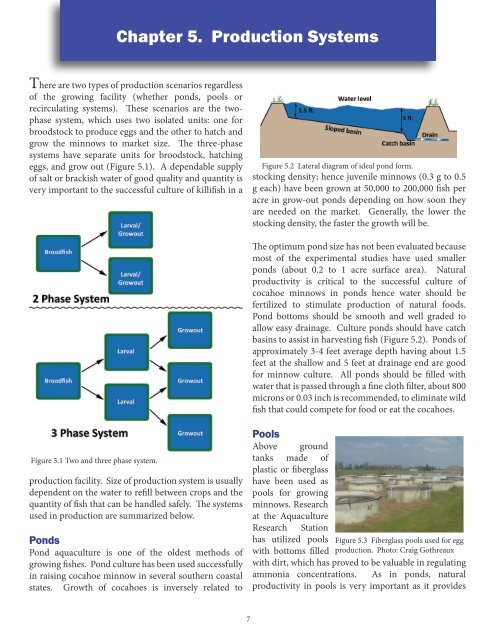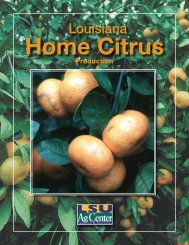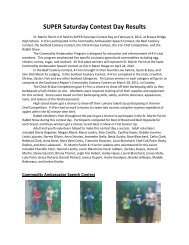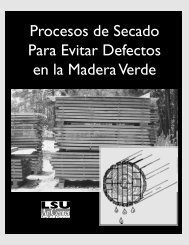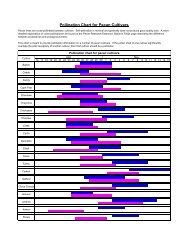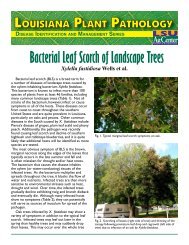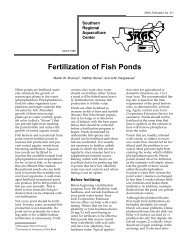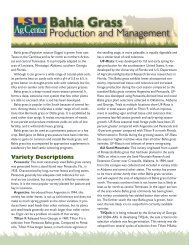Cocahoe Minnow - The LSU AgCenter
Cocahoe Minnow - The LSU AgCenter
Cocahoe Minnow - The LSU AgCenter
You also want an ePaper? Increase the reach of your titles
YUMPU automatically turns print PDFs into web optimized ePapers that Google loves.
<strong>The</strong>re are two types of production scenarios regardless<br />
of the growing facility (whether ponds, pools or<br />
recirculating systems). <strong>The</strong>se scenarios are the twophase<br />
system, which uses two isolated units: one for<br />
broodstock to produce eggs and the other to hatch and<br />
grow the minnows to market size. <strong>The</strong> three-phase<br />
systems have separate units for broodstock, hatching<br />
eggs, and grow out (Figure 5.1). A dependable supply<br />
of salt or brackish water of good quality and quantity is<br />
very important to the successful culture of killifish in a<br />
Figure 5.1 Two and three phase system.<br />
Chapter 5. Production Systems<br />
production facility. Size of production system is usually<br />
dependent on the water to refill between crops and the<br />
quantity of fish that can be handled safely. <strong>The</strong> systems<br />
used in production are summarized below.<br />
Ponds<br />
Pond aquaculture is one of the oldest methods of<br />
growing fishes. Pond culture has been used successfully<br />
in raising cocahoe minnow in several southern coastal<br />
states. Growth of cocahoes is inversely related to<br />
7<br />
Figure 5.2 Lateral diagram of ideal pond form.<br />
stocking density; hence juvenile minnows (0.3 g to 0.5<br />
g each) have been grown at 50,000 to 200,000 fish per<br />
acre in grow-out ponds depending on how soon they<br />
are needed on the market. Generally, the lower the<br />
stocking density, the faster the growth will be.<br />
<strong>The</strong> optimum pond size has not been evaluated because<br />
most of the experimental studies have used smaller<br />
ponds (about 0.2 to 1 acre surface area). Natural<br />
productivity is critical to the successful culture of<br />
cocahoe minnows in ponds hence water should be<br />
fertilized to stimulate production of natural foods.<br />
Pond bottoms should be smooth and well graded to<br />
allow easy drainage. Culture ponds should have catch<br />
basins to assist in harvesting fish (Figure 5.2). Ponds of<br />
approximately 3-4 feet average depth having about 1.5<br />
feet at the shallow and 5 feet at drainage end are good<br />
for minnow culture. All ponds should be filled with<br />
water that is passed through a fine cloth filter, about 800<br />
microns or 0.03 inch is recommended, to eliminate wild<br />
fish that could compete for food or eat the cocahoes.<br />
Pools<br />
Above ground<br />
tanks made of<br />
plastic or fiberglass<br />
have been used as<br />
pools for growing<br />
minnows. Research<br />
at the Aquaculture<br />
Research Station<br />
has utilized pools<br />
with bottoms filled<br />
Figure 5.3 Fiberglass pools used for egg<br />
production. Photo: Craig Gothreaux<br />
with dirt, which has proved to be valuable in regulating<br />
ammonia concentrations. As in ponds, natural<br />
productivity in pools is very important as it provides


